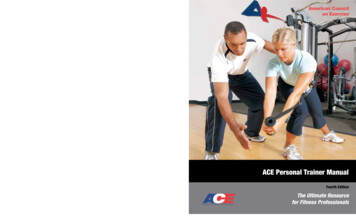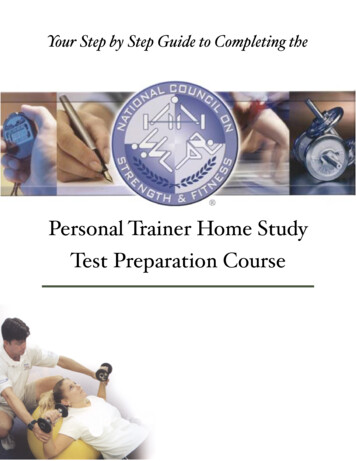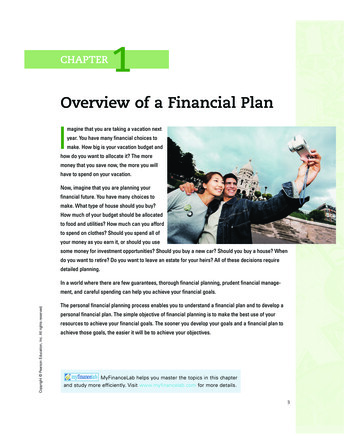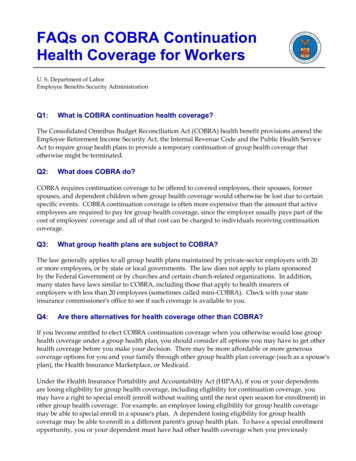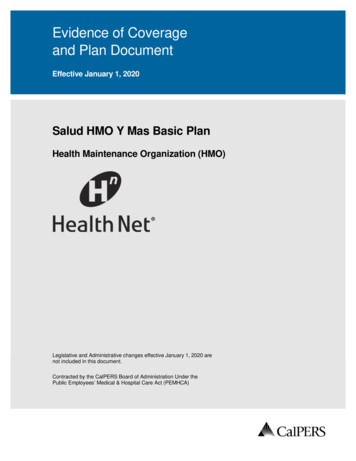
Transcription
PersonalHealth Plan Manual
PERSONAL HEALTH PLAN MANUALCopyright 2015 by Duke Integrative MedicineAll rights reserved. No part of this manual may be reproduced or transmitted in any form or byany means without written permission of the author.Disclaimer: The information included in this manual is for educational purposes only. It is notintended nor implied to be a substitute for professional medical advice. You should alwaysconsult your healthcare provider(s) to determine the appropriateness of the information for yourpersonal situation, or if you have questions regarding a medical condition or treatment options.Reading the information contained herein does not create a physician–patient relationship withDuke Integrative Medicine.August 2015 version
CONTENTSOverview .1Personal Health Plan .5Mindful Awareness .19Self-Care.27Movement, Exercise and Rest. 27Nutrition . 39Personal and Professional Development . 53Physical Environment . 57Relationships and Communication . 65Spirituality. 73Mind–Body Connection . 77Professional Care .87Integrative Medicine: A Whole-Person Approach . 87Natural Products. 103Mind and Body Practices . 113Other Complementary Health Approaches . 133Copyright 2015 by Duke Integrative Medicine
Copyright 2015 by Duke Integrative Medicine
OVERVIEWPERSONAL HEALTH PLANNING AND THE WHEEL OF HEALTHThis Personal Health Plan Manual will help you create a health plan that is unique to your needsand lifestyle. It will guide you to look at your current health concerns as well as consider yourfuture health. It uses the Wheel of Health (WOH), created by Duke Integrative Medicine, to helpwith your planning. The WOH is a visual reminder of many different layers of your whole lifeand health. All of these areas can impact health and have connections to one another. Yourcustomized health plan will be based on your personal values, goals and strengths. This manualdoes not prescribe or recommend specific treatment options. It does provide resources for you toconsider and choose what is best for you.The Personal Health Plan (PHP) is based on two important ideas: The human mind and body have the ability to self-repair. Your life choices combinedwith appropriate therapies and medical interventions can support and enhance thishealing. Ideal health is a journey that requires frequent reassessing and rebalancing.Five key concepts distinguish the PHP from other approaches:HealthThe PHP focuses on health optimization in addition to disease management. According to theWorld Health Organization, health is “a state of complete physical, mental and social well-beingand not merely the absence of disease or infirmity.” 1PlanningThe PHP encourages you to look beyond your current symptoms and health to develop aproactive plan for a healthy future.HealingNo matter what your condition, the PHP helps you envision and attain a future of well-being thatincludes balance and vitality.A Whole-Person ApproachThe PHP considers all of who you are—body, mind and spirit—as well as the community inwhich you live. It pays thoughtful attention to your personal goals, needs and lifestyle.Overview 1Copyright 2015 by Duke Integrative Medicine
SupportYour coach and healthcare team can help you implement your personal health plan and make itwork for you in the context of the real life you live.USING THE WHEEL OF HEALTH TO OPTIMIZE YOUR WELL-BEINGThis manual is designed to help you use the WOH along your journey to your best health. Wehope you will refer to this manual many times to discover ways to find balance and vitality inyour life.In the following sections, you will find in-depth information about each dimension of the WOH.Here is a helpful summary of each dimension.YouYou are at the center of your health. Your values, goals and priorities help to determine thecourse of your life. You are the most important consideration when it comes to planning for yourhealth.Mindful AwarenessWhen you pay attention to the present moment—without judging it in any way—you canexperience many health benefits. By being more aware of what is happening within you, you canrespond to changes in your life and health in a proactive and engaged way.The Seven Dimensions of Self-CareSelf-care includes all the choices you make that affect your physical, mental and spiritual wellbeing. The following seven dimensions of self-care are very important to your overall health. Asyou read each of these dimensions of self-care, consider what your life is like now in each areaand how you may want your life to be in the future.Dimension 1: Movement, Exercise and Rest Increase the performance of your body through healthy movement, exercise and rest. Create a plan that keeps you interested and motivated. An ideal fitness plan keeps youstrong, flexible and happy. Getting good sleep and rest leaves you feeling balanced and restored. It also givesyou more energy to do the things you want to do.2 Duke Integrative Medicine Personal Health PlanCopyright 2015 by Duke Integrative Medicine
Dimension 2: Nutrition Paying attention to what you eat and drink can nourish and strengthen your body andmind.Your health plan will help you develop healthy eating habits.You will learn how to choose foods and supplements that sustain your health and fityour lifestyle.You will also learn about regulating substances such as caffeine, alcohol and nicotine.Dimension 3: Personal and Professional Development An ongoing assessment of where you are with personal, career or life goals cansupport healthy behavior and lifestyle choices. This is especially important in times ofmajor life changes or milestones.Take a deeper look at work–life balance, financial goals and areas of personal growth.Dimension 4: Physical Environment Your surroundings at work and at home can affect your physical, emotional andspiritual health.Your overall health can be enhanced by improving the places where you spend themost time. This may include creating a space that enlivens each of the senses or aspecial place for your mind–body practices.You may want to select and arrange furniture to support your body and lifestyle.Addressing any concerns about toxins, safety, noise and clutter in your environmentwill also improve your health.Dimension 5: Relationships and CommunicationResearch shows that supportive relationships with your family, friends, co-workers andcolleagues are good for your health.Which of your relationships are based on open, respectful communication? Whichrelationships fuel you? Which ones drain you?By honestly evaluating your relationships, you can invest in your positive connectionswith others and minimize or reevaluate your choices in those that do not serve you.Overview 3Copyright 2015 by Duke Integrative Medicine
Dimension 6: Spirituality Having a sense of purpose and meaning in your life benefits all aspects of yourphysical and emotional health.Religion, prayer and spiritual connections have all been shown to enhance health andwell-being.Exploring your current spiritual beliefs may help you find more ways to enhance yourhealth and well-being.Dimension 7: Mind–Body Connection You can strengthen the connection between the mind and the body to nourish everyaspect of who you are. Mind–body skills such as breathing techniques, meditation and other therapies canincrease healing and reduce the harmful effects of stress.Professional CareThe many dimensions of the WOH are held within a ring of Professional Care that includesconventional and complementary approaches to both prevention and intervention.Prevention and InterventionThe goals of healthcare include overall health planning, disease prevention, early detectionand, when necessary, intervention.Conventional and Complementary ApproachesAn Integrative Medicine model of care employs a broad base of conventional andcomplementary evidence-based treatments and therapies. These therapies are described inmore detail in the last four chapters of this manual.4 Duke Integrative Medicine Personal Health PlanCopyright 2015 by Duke Integrative Medicine
PERSONAL HEALTH PLANYOU: DISCOVERING YOUR HEALTH GOALSYou are the ultimate owner of your life and your health. Being in the driver’s seat requires agood map. It is important to know your starting point and your destination. This means knowingwhat your health is like now and what you would like your health to be going forward. This maybe a new way to think about your health. Many of us are used to thinking about our health onlywhen we are sick. Whole person health and wellbeing means understanding what your life goalsare and what contributes to your sense of wellness over time.A personal health inventory will follow this introduction. Please take time to think about whereyou are now and where you want to be. Your health coach will review this personal healthinventory with you and use it as a tool to help you plan for your health in a way that fits yourunique life and goals.Personal Health Plan 5Copyright 2015 by Duke Integrative Medicine
Personal Health PlanFor:Date:Personal Health InventoryThe first step in creating your plan is to complete a personal health inventory to assess where youare now and where you want to be.1. How do I picture my best health?How would I like to feel and look? What activities would I like to be able to do?2. What is most important as I think about the picture of my best health?6 Duke Integrative Medicine Personal Health PlanCopyright 2015 by Duke Integrative Medicine
3. For each area, please take a moment to think about where you are now and where youwould like to be. Please complete as many of the boxes as you can. You may want to startwith the areas that are most interesting to you at this time. It is okay to just circle a numberfor each box if you prefer.Mindful AwarenessAwareness of the present moment; paying attention to what you are doing while you are doingit.Where are you now?Where would you like to be?On a scale of 1 (low) to 10 (high), how wouldyou rate this area of your life?12345678910Why did you choose this number?12345678910What changes could you make to help youget there?Movement, Exercise and RestActivities of daily living such as cleaning and gardening; exercise activities such as dancing,yoga, walking, running and cycling; adequate rest and relaxation.Where are you now?Where would you like to be?On a scale of 1 (low) to 10 (high), how wouldyou rate this area of your life?12345678Why did you choose this number?91012345678910What changes could you make to help youget there?Personal Health Plan 7Copyright 2015 by Duke Integrative Medicine
NutritionEating a balanced, healthy diet.Where are you now?Where would you like to be?On a scale of 1 (low) to 10 (high), how wouldyou rate this area of your life?12345678910Why did you choose this number?12345678910What changes could you make to help youget there?Personal and Professional DevelopmentGrowing and developing your abilities, talents and interests, both in your personal life and atwork; living with both in balance.Where are you now?Where would you like to be?On a scale of 1 (low) to 10 (high), how wouldyou rate this area of your life?12345678Why did you choose this number?91012345678910What changes could you make to help youget there?8 Duke Integrative Medicine Personal Health PlanCopyright 2015 by Duke Integrative Medicine
Physical EnvironmentSpaces where you live and work (including safety, light, noise, toxins and color), as well aslandscapes surrounding those spaces.Where are you now?Where would you like to be?On a scale of 1 (low) to 10 (high), how wouldyou rate this area of your life?12345678910Why did you choose this number?12345678910What changes could you make to help youget there?Relationships and CommunicationSpending time with family, friends and/or co-workers who are supportive and with whom youcommunicate effectively.Where are you now?Where would you like to be?On a scale of 1 (low) to 10 (high), how wouldyou rate this area of your life?12345678Why did you choose this number?91012345678910What changes could you make to help youget there?Personal Health Plan 9Copyright 2015 by Duke Integrative Medicine
SpiritualitySeeing purpose and meaning in something larger than yourself. This might include religiousaffiliation or other areas such as nature or the arts.Where are you now?Where would you like to be?On a scale of 1 (low) to 10 (high), how wouldyou rate this area of your life?12345678910Why did you choose this number?12345678910What changes could you make to help youget there?Mind–Body ConnectionPaying attention to the connection between the mind and body and the effects they have oneach other. Using techniques such as breathing and stress reduction practices to help the bodyrelax and heal.Where are you now?Where would you like to be?On a scale of 1 (low) to 10 (high), how wouldyou rate this area of your life?12345678Why did you choose this number?91012345678910What changes could you make to help youget there?10 Duke Integrative Medicine Personal Health PlanCopyright 2015 by Duke Integrative Medicine
Professional Care: Prevention and Intervention; Conventional andComplementary ApproachesRoutine screenings such as mammograms, prostate screenings, colonoscopies, pap tests anddental exams, along with prescribed use of vitamins and supplements. Following treatmentsrecommended by your conventional medical care providers as well as recommendedcomplementary approaches such as acupuncture, massage, hypnosis and osteopathy.Where are you now?Where would you like to be?On a scale of 1 (low) to 10 (high), how wouldyou rate this area of your life?12345678Why did you choose this number?91012345678910What changes could you make to help youget there?4. What stands out for you as significant about where you currently are in any given areaof the Wheel of Health?Personal Health Plan 11Copyright 2015 by Duke Integrative Medicine
5. If nothing changes in your health and well-being choices, what do you think your healthwill be like three years or ten years from now? What would be the worst-case scenario?6. If you make significant health behavior changes, what do you think your health will belike three years or ten years from now? What would be the best-case scenario?12 Duke Integrative Medicine Personal Health PlanCopyright 2015 by Duke Integrative Medicine
7. Place an X in the column that indicates when you would like to begin working on thatarea. If you do not anticipate a change in any given area, place an X in the last column.Area of Wheel ofHealthWithin thenext threemonthsWithin thenext yearNext one tothree yearsNo changesdesiredMindful AwarenessMovement,Exercise and RestNutritionPersonal ionships rofessional CarePrevention andInterventionPersonal Health Plan 13Copyright 2015 by Duke Integrative Medicine
Goal Setting GuideThe second step in creating your plan is to identify the areas you wish to focus on, the goals youwould like to achieve, and the action steps that will get you there.1. What area(s) of your health would you like to focus on now? What specific long-rangeoutcome(s) would you like to achieve?For example, losing 30 pounds in 6 months, stopping smoking, improving overall fitness, etc.2. What 3–6 month SMART goal(s) would help you meet the outcome you desire?For example, exercising three times a week on Monday, Wednesday and Friday after work for anhour each time, eating a 1,500-calorie well-balanced diet daily, etc.Your SMART goal should be:Specific: Your goals should be clear and concise. If your goal is not specific, it isdifficult to know when your action begins and when it is complete.Measurable: A goal should be measurable so you can track your progress. You need tohave clear criteria for progress and completion when taking action on a goal. Keepingtrack of your progress can be inspiring.Action-Oriented: A goal should include action, and that action should be in your directcontrol.Realistic: A goal should be realistic. It is best to work on small lifestyle changes that areeasy to complete. Focus on the small steps instead of feeling overwhelmed by the bigpicture.Timed: A goal should be tied to a timetable for completing specific, measurable andrealistic action.SMART Goal 1SMART Goal 214 Duke Integrative Medicine Personal Health PlanCopyright 2015 by Duke Integrative Medicine
3. Is there more than one option for meeting your SMART goal? If so, what are theseoptions? Which one(s) appeal to you now to get you started?For example, if your goal is to begin exercising three times a week after work on Monday,Wednesday and Friday for an hour each session, what kinds of exercise appeal to you? Wouldyou like to exercise alone or with others? What options would you like to consider?4. What are the SMART steps you want to start in Week One to begin working on your 3–6month goal(s)?For example, do you need to purchase any equipment such as a bike or bike helmet, runningshoes or gym membership? Do you want to start exercising this week for 20 minutes at a time towork up to your goal of one hour each time? Do you need to speak with a medical provider forclearance for a new exercise program? Do you need to meet with a nutritionist to plan a wellbalanced diet? Make sure the SMART steps meet the same criteria as the SMART goals.Goal I—SMART StepsSMART Step 1SMART Step 2SMART Step 3SMART Step 4Personal Health Plan 15Copyright 2015 by Duke Integrative Medicine
Goal II—SMART StepsSMART Step 1SMART Step 2SMART Step 3SMART Step 45. What have you learned about yourself from other times you have made changes to yourhealth and lifestyle? What strengths do you bring to your health goals? Are you skillful at planning new initiatives? Can you bring your organizational,planning and tracking skills to this new behavior change? How will you do that? Do you have more energy and time in the mornings or evenings? Do you have more success when you plan goals that include connection with otherpeople, or do you prefer to work alone?16 Duke Integrative Medicine Personal Health PlanCopyright 2015 by Duke Integrative Medicine
6. What are some hurdles or barriers that you might encounter? What are your strategiesfor success? Do you need to make any arrangements with work or family so you can meet yourgoals? What will you do if bad weather, vacations or parties interrupt your schedule?Barrier 1StrategyBarrier 2StrategyBarrier 3StrategyBarrier 4Strategy7. How will you hold yourself accountable and to whom?Personal Health Plan 17Copyright 2015 by Duke Integrative Medicine
Coaching Session Prep FormOne helpful way to achieve your personal health goals is to take the time to regularly evaluateyour progress. This form is designed to give you a quick way to track your progress toward yourgoals and identify any changes you need to make to achieve them.1. What have you accomplished since your last coaching session? What were your small orlarge successes or new insights?2. What are the biggest challenges you are facing right now?3. How are you addressing the challenges that you are facing in order to move forward toyour goals?4. What would you like to focus on in your next coaching session?18 Duke Integrative Medicine Personal Health PlanCopyright 2015 by Duke Integrative Medicine
MINDFUL AWARENESSOVERVIEWImagine a moment when you feel a cool breeze across your face as you step outside of a buildingon a hot day. Imagine the instant when you notice the sound of a car passing or a plane overhead.Imagine the moment you realize a stream of angry or worried thoughts has filled your mind orthat your muscles are feeling tense. This is mindful awareness—noticing what is happening to usin the moment. The more you notice about what is happening, the more you are able to choose ahealthy response. You can become better at mindful awareness with practice.PROMOTING OVERALL HEALTHHave you ever started eating an ice cream cone, taken a lick or two, and then noticed in whatseemed like an instant that all you had was a sticky napkin in your hand? Or perhaps you haveheaded somewhere and arrived at your destination, only to realize you had not noticed anythingor anyone you met along the way? Of course you have—we all have! These are commonexamples of “mindlessness” or, as some people put it, “going on automatic pilot.”We all fall into habits of mind and body, of attention and inattention, which result in our notbeing present for our own lives. The results of this inattention can be quite costly. You can misssome great experiences or ignore important information and messages about your life, yourrelationships and even your own health.One way to change this tendency to “tune-out” is to practice mindful awareness. Practicingmindful awareness means to pay careful attention in a particular way. When you are mindful,you are aware of what is going on outside and inside your own skin. All of your senses are aliveand active and you know what is happening in the present moment. You pay attention withouttrying to change anything. You become deeply aware of what you are sensing.Western medical science is learning that mindful awareness can be good for your health and canreduce stress in many common conditions, such as: Heart disease Chronic pain Cancer Menopause Weight managementMindful Awareness 19Copyright 2015 by Duke Integrative Medicine
WHY PRACTICE MINDFUL AWARENESS?Regular and ongoing practice of mindful awareness can bring more joy and good health intoyour life. At the most basic level, being more aware allows you to identify and focus on keyissues before they get out of control.Your body and mind are sending you messages all the time. When you become aware of aproblem early, it is easier to treat the problem. Current research shows that practicing mindfulawareness reduces stress and helps you enhance your emotional well-being and quality of life.Mindful Awareness ResearchResearch shows that mindful awareness can help improve these areas of your life: Mental and physical health Eating and sleeping habits Substance abuse Spirituality Relationships with others 2,3Mindful Awareness and the MindResearch shows that mindful awareness leads to lower levels of anxiety, depression, anger andworry. People who are more mindful say they feel more joyful, grateful and satisfied with life. Inaddition, being in a mindful state for just a moment can give you a greater sense of wellbeing.2, 4, 5, 6, 7, 8Mindful Awareness and the BrainMindful awareness helps you pay attention to the present moment. In a recent study, people whotook eight weeks of meditation training were able to pay better attention to what was happeningaround them. 9Mindful awareness also helps you recognize emotions. One study found that mindful people hadbetter control over emotional reactions. Other studies showed that mindful awareness practiceleads to more activity in parts of the brain associated with joy, contentment and love. 10, 11,12Mindful Awareness and the BodyPracticing mindful awareness helps your body as well as your mind. It can ease chronic pain andother stress-related symptoms. It can also teach you to cope with the stresses of daily life. As youpractice mindful awareness, you are learning to pay attention to signs that something might bewrong with your body. However, it is important to remember that there is usually more rightwith your body than there is wrong with it.13,1420 Duke Integrative Medicine Personal Health PlanCopyright 2015 by Duke Integrative Medicine
Mindful Awareness and BehaviorWhen you become more aware, you can simply observe your thoughts, emotions and physicalsensations. Mindful awareness can help you see patterns in your behavior and figure out how tobreak bad habits. For instance, you can learn to identify when stress makes you want a cigaretteor when sadness makes you want to overeat.As you practice becoming more mindful, you may find that it is easier to feel stress withoutreacting in a harmful way. Studies have shown that people who trained in mindful awarenesshave an easier time understanding and coping with stressful situations, such as: 7,15,16 Quitting smoking Decreasing binge eating Reducing illegal drug useHOW TO PRACTICE MINDFUL AWARENESSYou can read a thousand books about apples, talk to a hundred farmers or cooks about them andview dozens of photos and paintings, but not one of those experiences will be like actuallyholding an apple in your hand and taking a bite out of it! Like the apple, understanding whatmindful awareness truly is and realizing the benefits mindful awareness can offer comes onlythrough your own direct experience of practice.Informal Mindful Awareness PracticeInformal practice is simply being aware during the tasks and experiences of daily life. Wheneveryou think of it, day or night, remember that you can be more mindful. At any time, you can turnyour attention to what is here at this very moment, especially in your own body, heart and mind.This is often called informal practice, and it refers to a way of paying attention to whatever ishappening in the moment.In order to get better at mindful awareness, you may make the commitment to practice payingattention on purpose. Try spending two minutes before a meeting being silent and focusing onyour breath. Or start your exercise routine with a moment of sensing what is happening in yourbody. When you are waiting in line at the grocery store, quietly notice the sounds, sensations andsights around you. You can practice being present throughout the day, such as when you are: Washing dishes Eating a meal Walking the dogMindful Awareness 21Copyright 2015 by Duke Integrative Medicine
In these situations, use the sensation of the breath as the anchor for awareness in the presentmoment. Establish mindful awareness with a narrow focus on just the breath sensation. Allowyourself to feel the breath as it goes in, as it goes out, and observe the pause between in and out.Do not try to control the breath. Simply let it come and go. Bring as much attention, completelyand continuously, as you can to the direct sensation of the breath.If you wish, once you have established awareness on the breath sensation, you can widen yourfocus to include all body sensations. Again, you are not trying to change anything. You aresimply allowing yourself to be aware of the changing sensations in the body.After a while, you may further widen your focus to include all that is present. You can allowyourself to become aware of whatever you are hearing, seeing, tasting, smelling, touching oreven thinking. Just practice being with these different experiences as they unfold. Allow yourselfto feel your life in this moment and rest in the openhearted awareness of what is in this moment.Any time you feel lost, confused or frustrated, gently narrow your focus and return awareness tothe sensation of your breath. You may have to do this frequently to calm yourself. One momentof mindful awareness—one breath when we are truly present—can be profound. See foryourself. You can practice mindful awareness in this way, throughout the day and night. Practicefor a few breaths at a time, or find a few mindful moments. Next, you will find easy-to-followinstructions for doing your own practice of mindful breathing.Formal Mindful Awareness PracticeA formal mindful awareness practice involves setting aside time (from a few minutes to an houror more, as you wish) for daily practice. During this time, you should be free from otheractivities or distractions. You need to be able to devote your full attention to simply beingmindful of what is present. Over time, you may find that this kind of practice makes it easier foryou to practice mindful awareness during your daily life.At the heart of formal mindful awareness practice is sitting. This is time set aside to sit andobserve the present moment, paying attention on purpose and without judgment.To practice formal sitting, first decide where, when and how long you want to practice. Find aplace that is free of distraction. Select a time of the day when you can devote a concentratedperiod of time to your practice. You may want to practice firs
This manual is designed to help you use the WOH along your journey to your best health. We hope you will refer to this manual many times to discover ways to find balance and vitality in your life. In the following sections, you will find in-depth information about each dimension of




